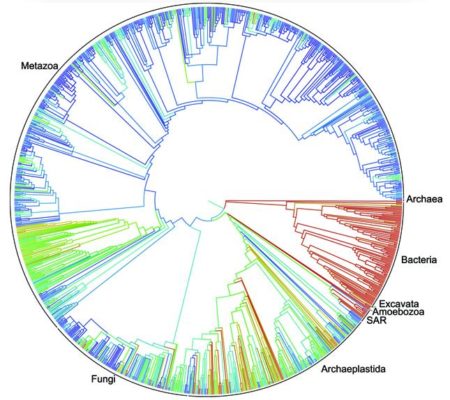Every parent knows the joy of watching a child discover something for the first time. But, as children grow older, it gets harder to elicit a sense of awe. When I was a professor at the University of Wisconsin in Madison, I used to tell my students there were “billions and billions” of living things. That’s an exaggeration. But I used it to try to convey some sense of the vast array of life around us.
But knowing the expanse of the universe and the life within it can also be overwhelming. Now, a new “Tree of Life” project may offer a helpful way for students (and everyone else) to better grasp the subject of biology and how life is interconnected. Read on for some info and context into the “Tree of Life.”
Species
How many kinds, or species, of living things are there? The most recent guess, by the Census of Marine Life, is that there are 8.7 million species of life on Earth. That is 8,700,000 different types of living things—from bacteria to elephants. For comparison, a stack of nine million pennies would be 45,000 feet high. Let’s just say that 8.7 million is a lot! It may further surprise you to know that about 2.3 million of these species have been named by scientists.
We’ve reached the point where our knowledge has almost outstripped our ability to make sense of it all. Forget about the 6.4 million species we don’t know anything about, how do we keep track of the 2.3 million species we DO know? Not only do we know their names, we know a lot about how they are interrelated. We also know a ton about their phylogeny, the so-called Tree of Life.
The Open Tree of Life
So how can we keep track of what’s out there and how it’s all related? That’s the problem of what we call “big data.” But strides are being made. A team of scientists recently published a digital database of life, called The Open Tree of Life, in the Proceedings of the National Academy of Sciences.
To create the database, they collected phylogenetic data from hundreds of published studies. Each study was of one small group of living things. Some of these studies did not come with digital databases, and when they did, they were of very different types. More than just organizing all the information into one useable database, scientists created this visual tree that shows the interrelationships of living things:
 via CBSnews.com
via CBSnews.com
“This is the first real attempt to connect the dots and put it all together. Think of it as version 1.0,” said principal investigator Karen Cranston of Duke University. Over the years, scientists will add to this, and the tree will grow.
Narrowing It Down
As you examine the tree, you’ll notice that the major groups of living things include Metazoa (animals), fungi, Archaeplastida (plants and many algae), bacteria, the archaea, and some odd groups that don’t fit into the traditional groups. You can use this interactive wheel to explore the lifestyle, habitat, and traits of several species.
If it helps, focus on just one of the 8.7 million species with your kids. Take, for example, Homo sapiens. Each human cell contains 48 chromosomes and a total of 3.3 billion base pairs (the haploid number), which hide within their lineup about 25,000 genes that create at least 250,000 different proteins. Now that’s amazing (not to mention beyond comprehension)!
This brings me back to “billions and billions.” The Open Tree of Life is indicative of a new age in biology and acts as a new doorway to the appreciation of life on Earth. It’s fun to explore this with your kids. Even if it is a little overwhelming, they’ll get a small glimpse of the incredible diversity and beautiful intricacies of living things.
Featured Image – subflux / cc by 2.0





























































































